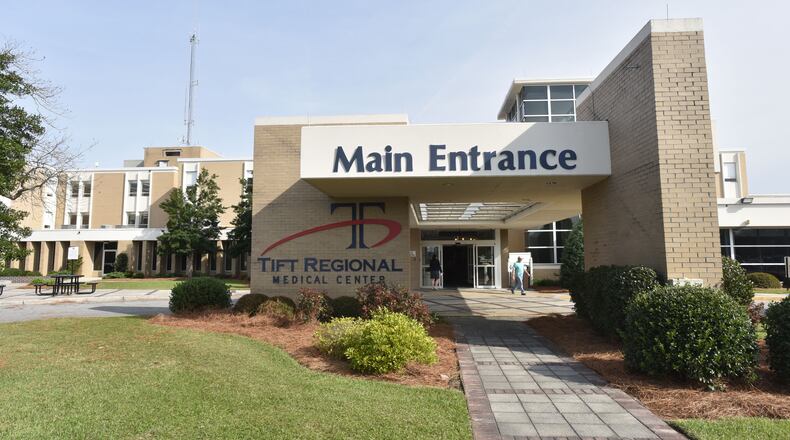Georgia hospitals in at least two of the state’s health regions have run out of Intensive Care Unit beds, forcing them to improvise space, scramble for staff and to send some patients on journeys to other parts of the state for care.
As coronavirus cases have soared, all ICU beds of the Athens region’s 12 counties have been full since Friday, according to state figures. In south central Georgia, the state shows Tift Regional Medical Center’s nine-county region down to two ICU beds, but that is outdated, Tift’s CEO said Tuesday afternoon.
“I have no ICU beds,” said Chris Dorman. And for several days, he has been unable to find any anywhere else in the state.
The surge also has some hospitals treating emergency patients in hallways, on waiting room chairs and in idle ambulances.
The state’s COVID-19 case count has soared for weeks, and as expected serious cases and deaths have spiked, too, reaching levels not seen even in the crisis this spring. On Tuesday the state reported 4,293 new cases and 54 deaths, with 406 new hospitalizations.
The summer surge has caught the state flat footed, and with bed shortages plaguing multiple hospitals, Georgia plans to finally centralize decision-making on how to get the sickest patients to the nearest available beds.
Within the next week, the state expects to launch a statewide coordinating center based at Grady Memorial Hospital, which will monitor patient capacity and patient overflows and act as a sort of air traffic control in shifting or diverting patients when hospitals become overrun, Cody Hall, a spokesman for Gov. Brian Kemp, told The Atlanta Journal-Constitution on Tuesday. The state has budgeted $1.2 million for the new coordinating center.
The state also is close to re-opening a temporary hospital with perhaps 120 beds for non-critical coronavirus patients set up inside the Georgia World Congress Center. An overflow facility is also in the works in Milledgeville. The state has also contracted with Piedmont Healthcare for 62 overflow beds at the Buckhead campus’ main hospital. The first of those beds opened Tuesday.
The issue isn’t merely space and beds. Patients entering ICU’s require specialized equipment, critical care physicians and nurses with specialized training to manage the unit’s complicated machines, medicines and treatments.
Dorman needs 12 such nurses, now, at his 181-bed facility that anchors its region.
“It’s terrible,” Dorman said. “I’m having to have to find places for patients in other hospitals. But everybody in the state of Georgia is struggling with the same thing.”
The Athens region first plummeted to zero critical care beds on Friday’s daily situation report posted by the Georgia Emergency Management and Homeland Security Agency. That was the first time Amber Schmidtke, a public health microbiologist who tracks the data, had seen an available bed figure hit zero. She said she considers any region with less than five beds to be in a dire situation.
Piedmont Athens Regional Medical Center would not address the lack of ICU beds but acknowledged in a statement that patient volumes fluctuate. St. Mary’s Hospital in Athens acknowledged that it was declining requests to take ICU patients and diverting ambulances with critical care patients.
Both hospitals said they could meet needs by calling on sister facilities.
Before the pandemic, Georgia hospitals often operated nearly full and it’s nothing new to divert incoming ambulances to other ERs for an hour or so. But it is unique to find entire regions across the state unable to take up the slack.
A live list kept by the state indicates that several regions still have a slim margin of ICU beds available, but that doesn’t mean that when a fellow hospital calls, they feel they can risk sharing.
“I had a patient last week I was trying to get out of here, the nearest bed was Chattanooga,” Dorman said. “There was no way. No ambulance, airplane, nobody could accommodate that much oxygen.”
Tift made space for the patient in the hospital.
Hospitals do seem to have space and staff for non-critical patients.
But a domino effect starts with COVID-19 patients who show up very sick and stay in ICU’s for long periods of time. When the ICU fills, some less sick ICU patients can move to improvised ICU beds in the hospital. Regular hospital patients then move elsewhere, perhaps to other hospitals.
Dorman said he had 21 patients in need of hospital beds Tuesday who were instead waiting in emergency department beds for hospital space to open up.
Tift Regional was treating six ER patients in the hallway. Other ER patients who normally would have been monitored in exam rooms—with staff checking their vital signs to watch their progress, for example—were still seated in the waiting room. Staff would come out and check the vitals there.
In Brunswick, patients waiting to be seen in the ER were instead marking time outside in ambulances, The Brunswick News reported, with the EMT waiting with the patient until space opened up.
The facilities emphasized they were still giving hospital-level care. But they are bursting and staff are tired.
Monday night a fellow hospital CEO texted Dorman saying they were out of ventilators. Dorman called his COO, Alex Le, who drove four ventilators to the other hospital, as a loan.
Meanwhile patients and their caregivers in the new or coming hot spots can only wait to see if hospitals have room if their time comes.
Small Elbert Memorial Hospital is 35 miles from Athens Regional Medical Center, but Athens is where it would send complicated critically ill cases if they needed the next level of care, said Elbert Memorial’s CEO, Kerry Trapnell. If it can’t take them, what would he do?
“That,” he said, “would be a problem.”
Staff writers Willoughby Mariano and Yamil Berard contributed to this report.
Keep Reading
The Latest
Featured



